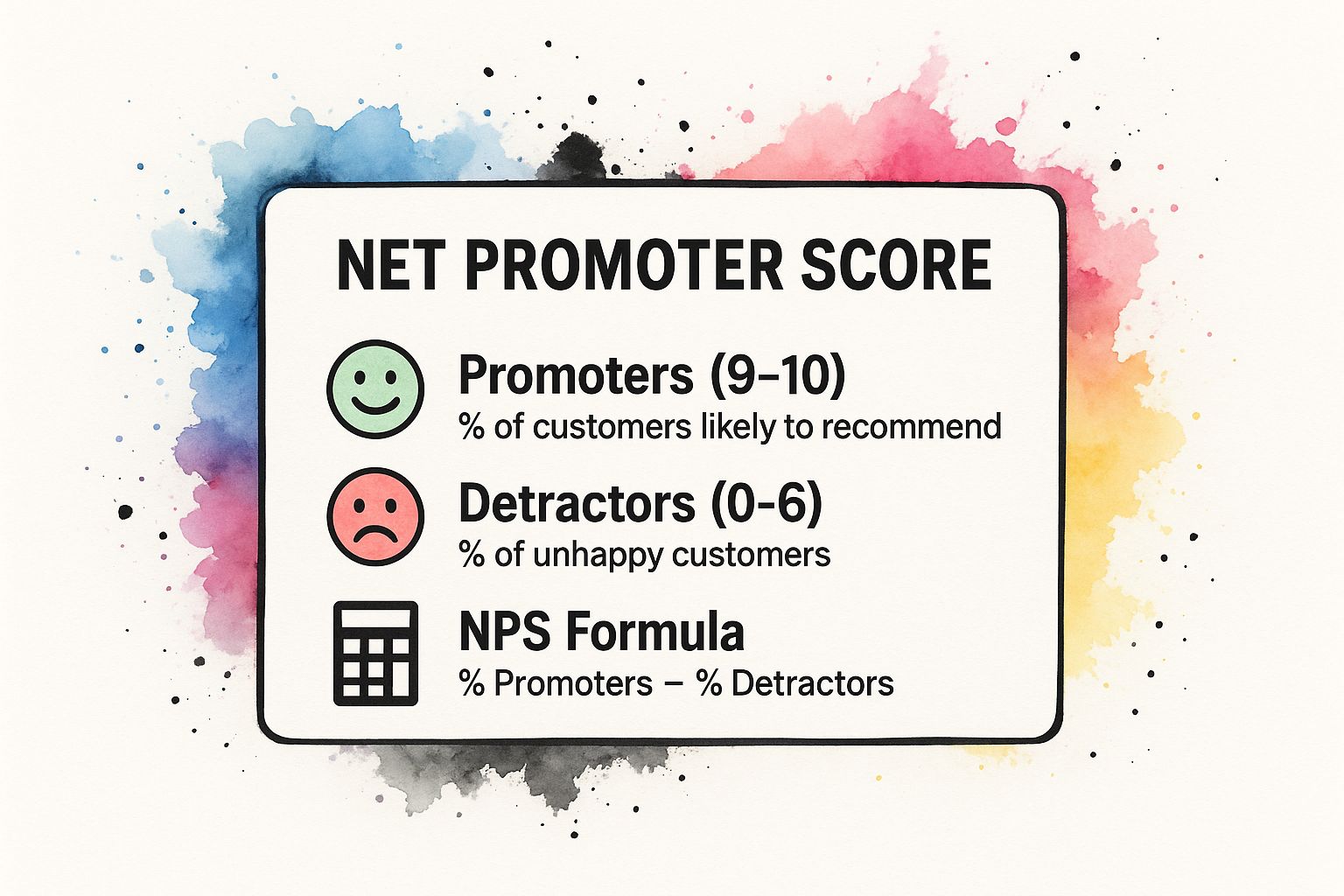Stop Guessing. These Are the Only Customer Satisfaction Measurement Methods That Matter.
Discover effective customer satisfaction measurement methods to improve your business. Learn the top techniques for accurate insights today!
Posted by
Related reading
Stop Asking Useless Survey Questions. Steal These Instead.
Stop guessing. Get battle-tested survey questions examples to find out what your customers actually want. Real talk, no fluff. Just actionable insights.
Surveys vs. Questionnaires: Stop Confusing The Hammer For The Blueprint
Uncover the difference between surveys and questionnaires, when to use each, and practical tips to improve your research results.
Your Gut Feeling Is a Garbage Business Partner
Tired of useless data? Learn how to create a poll that delivers actionable insights. Get battle-tested advice for founders who need answers now.
Let’s cut the crap. You’re here because you suspect something's broken. Your growth has flatlined, churn is a quiet poison, and the little voice in your head is screaming that your “amazing” product might be a buggy mess your customers secretly hate. You’ve been told to “listen to your customers,” which is the most useless advice on the planet. It’s like telling a starving man to “eat food.”
The real question isn’t if you should listen; it’s how you turn their angry rants and quiet frustrations into a roadmap that prints money. Most founders treat feedback like a vanity project. They chase a high NPS score to slap on a pitch deck while their company slowly bleeds out from a thousand tiny cuts. This isn't about collecting happy quotes. This is about finding the friction that’s silently killing you.
Ignore your customers, and you’ll be lucky to survive the quarter.
1. Net Promoter Score (NPS): Your Loyalty X-Ray
You think people love your product? That’s cute. Your opinion doesn’t pay the bills. The only thing that matters is whether a customer would stake their reputation on recommending you. That’s the brutal truth NPS forces you to confront.
It asks one question: "On a scale of 0-10, how likely are you to recommend us?"
- Promoters (9-10): Your unpaid sales team. They're your growth engine.
- Passives (7-8): Satisfied, but not loyal. A competitor's shiny object will steal them. They’re a churn risk in disguise.
- Detractors (0-6): Ticking time bombs. They actively sabotage your reputation.
Your score is % Promoters - % Detractors. The score is a compass, not the destination. The real gold is in the mandatory follow-up question: "What is the primary reason for your score?" Ignore that, and you're just collecting numbers for a pretty dashboard that does nothing.

Here's how not to waste everyone's time:
- Call your Detractors. Within 24 hours. Don't argue. Just listen and fix their problem. It's the fastest way to turn a hater into a fan.
- Weaponize your Promoters. They just told you they love you. Ask for a testimonial. A review. A referral. Don't be shy.
- Segment everything. Your overall score is a useless average. What’s the NPS for new users vs. power users? What about for customers on your cheap plan vs. your enterprise plan? Find the fires you didn't know were burning.
The Takeaway: Stop guessing if people like you; NPS gives you the raw, unfiltered truth about whether you've built something worth talking about.
2. Customer Satisfaction Score (CSAT): Your Transactional Polygraph
Wondering if that new feature landed well? Or if your support team actually solved the problem? Stop guessing. CSAT is your real-time, in-the-moment satisfaction polygraph. It’s not about long-term loyalty; it’s about right now.
You ask: "How satisfied were you with [the thing that just happened]?" on a 5-point scale. Anything less than a 4 ("Satisfied") is a failure. Most companies slap this on the end of a support ticket and call it a day. That’s lazy. A low CSAT score isn’t a failure; it’s a gift. It’s a customer raising their hand and telling you exactly where your business is broken. Ignoring that is managerial malpractice.

How to use it to find the fires:
- Be hyper-specific. Don't ask about their "experience." Ask about the support call they just finished, the onboarding they just completed, or the checkout they just suffered through.
- Track trends, not scores. Is one support agent consistently getting low scores? Is one feature release tanking your average? A single score is a snapshot. A trend is a story.
- Ask "what could we do better?" The score tells you that you failed. The open-ended follow-up is where they give you the repair manual for free.
The Takeaway: If NPS is about whether they’ll recommend you tomorrow, CSAT is about whether you pissed them off today.
3. Customer Effort Score (CES): Your Friction Detector
You think delighting customers is the key? Wrong. Stop wasting money on “wow moments” that don’t move the needle. The #1 driver of disloyalty isn’t a lack of delight; it’s making your customers work too hard. CES drags this ugly truth into the light.
It asks: "How easy was it to get your issue resolved?" The goal isn't a high score; it's a low one. A high-effort experience is a direct predictor of churn. Delight is fragile and expensive. Low effort is robust and profitable. Customers will forgive a missing feature, but they will never forgive you for wasting their time.
Here's how to stop annoying people:
- Deploy it after any service interaction. The moment a support ticket is closed or a return is processed. The memory of their frustration is fresh.
- Map the high-effort hotspots. Is checkout a breeze but your returns process a nightmare? CES pinpoints the exact cog in your machine that's grinding your customers to a halt.
- Fix the process, not just the ticket. When a customer reports high effort, don't just solve their individual problem. Ask: "What broken process created this mess?" Fix the root cause so no one else has to suffer.
The Takeaway: Stop asking if they love you and start asking how hard you made them work; their loyalty depends on it.
4. Voice of Customer (VoC): Your Business’s Central Nervous System
You think you know what your customers want? You don't. You have a distorted echo of their needs filtered through your own biases. A VoC program is about shutting up, opening every possible listening post, and building a system to translate their raw, messy feedback into a coherent roadmap.
This isn’t a survey. It's a company-wide commitment to pulling in feedback from everywhere—surveys, support tickets, sales calls, angry tweets, App Store reviews—and funneling it to the people who can do something about it. Most companies pay lip service to listening. They stick feedback in a spreadsheet to die. A real VoC program is an active, operational process, not a data graveyard.
How to build one that isn't just corporate theater:
- Centralize the chaos. Your feedback is scattered across a dozen tools. Get it all in one place. You can’t spot patterns if you’re looking at ten different dashboards.
- Assign ownership. Every piece of feedback needs an owner. A bug report gets tied to an engineering ticket. A feature request goes to the product team's backlog.
- Close the loop. This is the non-negotiable part. When you fix a bug a customer reported, email them and tell them. You'll create a fan for life.
The Takeaway: Stop treating feedback like a suggestion box; make it the central nervous system of your entire business.
5. Post-Purchase Surveys: Your First-Bite Reaction
The moment a customer clicks "buy" isn't the end; it's the start of your next sale. The tiny window after they've bought—but before they've forgotten you exist—is a golden opportunity. Post-purchase surveys pry that window open.
You're leveraging peak attention. They just gave you money. Their feelings are at their most potent. Ignoring this is like a chef cooking a meal and then leaving before the customer takes their first bite. You miss the most honest reaction. A customer’s inbox is a warzone. Your survey is an intruder. To win, it must be short, relevant, and hyper-focused.
How to not get ignored:
- Strike while the iron is hot. Send it within 24-72 hours of delivery. Any later and their memory is fuzzy and their motivation is zero.
- Keep it brutally short. One to three questions, max. Respect their time.
- Personalize or perish. Reference the exact product they bought. "How are you enjoying the [Product Name]?" is infinitely better than "Thanks for your purchase." To get even better feedback, using tools for email parsing can automate the analysis of their replies. This is how you get customer feedback that's actually useful.
The Takeaway: The sale isn't over until you know how it went; otherwise, you’re just guessing why they never come back.
6. Customer Exit Surveys: Your Business Autopsy
A customer canceling isn't just lost revenue; it's a crime scene. If you're not conducting an investigation, you're letting the culprits who murdered your retention get away clean. Exit surveys are your forensic toolkit. It's where you ask: "What is the primary reason you are leaving?"
You don't get sugar-coated feedback here. You get the raw, brutal truth. One customer leaving because your price is too high is an anecdote. Fifty leaving for the same reason is a catastrophic failure. Exit surveys turn individual complaints into undeniable data trends.
How to do it without begging:
- Make it mandatory. Make it a required step in the cancellation flow. Ask one multiple-choice question and an optional text box. That's it.
- Automate win-back offers. If they select "Price," trigger an automated offer for a discount. You won't save them all, but you'll learn your price elasticity.
- Feed the insights directly to Product. If "Missing Feature X" is your #1 reason for churn, it better be at the top of the next sprint planning meeting.
The Takeaway: Stop treating churn as a cost of doing business; use exit surveys to diagnose the disease, not just count the dead.
7. Social Media Sentiment Analysis: Your Digital Eavesdropping Tool
You think your brand is what you post on social media? Wrong. Your brand is what thousands of people are screaming about you on Twitter and Reddit. Social Media Sentiment Analysis is your ear to the ground, using AI to eavesdrop on that conversation at scale.
It scans platforms, tagging mentions as positive, negative, or neutral. It tells you the feeling behind the metrics. A viral post can be a PR disaster or a triumph; volume alone is worthless. This is how you spot a wildfire starting when it's still just a spark.

How to use it without drowning in noise:
- Set up crisis alerts. Trigger an alarm for a sudden drop in sentiment or a spike in negative keywords. It's your early warning system for a viral complaint.
- Benchmark against competitors. Don't just track yourself. Track your rivals. Their public feedback is your free product roadmap. Dig into communities by decoding Reddit sentiment analysis.
- Monitor launches in real-time. Catch bugs and feature complaints within hours, not weeks.
The Takeaway: Stop guessing what the public thinks; tap into the world’s biggest focus group and listen to what they’re already telling you.
You Have the Data. Now What?
So, you have the toolkit. NPS, CSAT, CES. You can measure anything. But here’s the hard truth: a dashboard full of charts is worthless. Knowing your NPS is 42 is a vanity metric unless it triggers an immediate, tangible action. Collecting data isn't the job. The job is turning that data into decisions.
The real gold isn’t in the scores. It's buried in the messy, angry, free-text responses.
- The angry rants? Your most urgent bugs.
- The feature ideas? Your future roadmap, crowdsourced for free.
- The "why I'm canceling" essays? Your brutally honest churn report.
Ignoring this is like a doctor reading a patient's temperature but refusing to listen to their symptoms. The best founders don't just measure satisfaction; they weaponize it. They build a tight loop: Capture feedback relentlessly, analyze it immediately, and act decisively. Then, they close the loop by telling the customer, "Hey, you said X was broken. We fixed it." That one action creates evangelists.
Your customers are giving you a free, perpetual consulting engagement on how to build a business they can't live without. The only metric that matters is how quickly you act on their advice.
The real bottleneck isn't collecting feedback; it's making sense of the messy, unstructured comments to find actionable priorities. Backsy.ai uses AI to instantly analyze all your qualitative customer feedback from any source, turning angry rants and feature requests into a crystal-clear, prioritized roadmap. Stop guessing what to build next and see what your customers are really telling you at Backsy.ai.